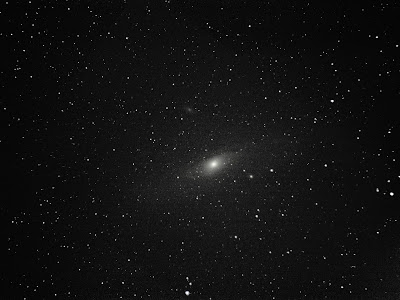For comparison, my previous attempt was during a gibbous moon with 318 light frames. This time around, I had a new moon and 667 light frames (but I chose to keep the best 80%, so an effective 534 total subs). Total exposure time is around 11 minutes. Images were taken with Canon Rebel XT (350D) on a fixed tripod.
 |
| Stack of 534 subs, 94 darks, 104 bias, f/5.6, 300mm, ISO 1600, 1.3 sec each Layered with my previous image at 30% transparency |
It's definitely more recognizable than just a fuzzy blob! Granted, it's got plenty of fuzz and blob to go around. I try to remind myself that this is with a relatively slow lens and 8 megapixel camera (Canon Rebel XT) so it's not going to be Hubble quality. It's a baby step, and my best Andromeda to date! Still, after two nights of shooting, 4 hours of image stacking, and 2 hours of image processing, I had high expectations!
 |
| Dust trails are visible on M31 as darker lines on the top ridge. M110 and M32 are featureless but visible nonetheless. |
 |
| Baby steps, improvement over my first Andromeda attempt |
Update: Planning my shot...
Jason in the comments asked for an unprocessed light frame, but I can do one better. Here is some more info on how I planned out the shot.
 |
| First I find the right general area by star-hopping from Mirach to the left |


Could you post one of your light frames unprocessed please? I tried photographing M31 with my new cameraa couple of nights ago but I couldn't even locate it with binoculars! I took a few photos of the general Cassiopeia area and I've pinpointed where it should be, but there's nothing in the picture. I think there may be too much light pollution where I am and o just want to see a comparison photo before I spend a lot of time taking shots for a stack!
ReplyDeleteThanks
Hi Jason, I added some more content to the bottom of the post. I hope this helps! Instead of binoculars I'd try locating it with an 8 sec exposure and looking for a fuzzy blob.
ReplyDeleteThanks! I've got clear skies forecast tonight so I'll give it another shot
ReplyDelete